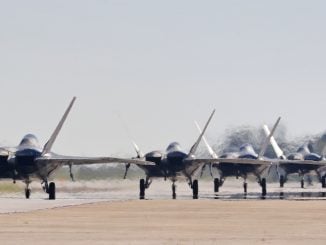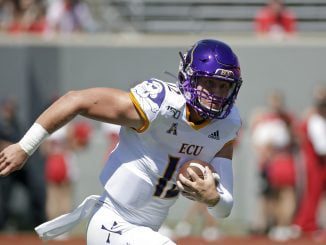
The Navy’s ability to build lower-cost warships that can shoot down Houthi rebel missiles in the Red Sea depends partly on a 25-year-old laborer who previously made parts for garbage trucks.
Lucas Andreini, a welder at Fincantieri Marinette Marine in Marinette, Wisconsin, is among thousands of young workers who’ve received employer-sponsored training nationwide as shipyards struggle to hire and retain employees.
The labor shortage is one of myriad challenges that have led to ship production and maintenance backlogs at a time when the Navy faces expanding global threats. Combined with shifting defense priorities, last-minute design changes and cost overruns, this has put the U.S. behind China in the number of ships at its disposal — and the gap is widening.
Navy shipbuilding is currently in “a terrible state” — the worst in a quarter century, says Eric Labs, a longtime naval analyst at the Congressional Budget Office. “I feel alarmed,” he said. “I don’t see a fast, easy way to escape this problem. It’s taken us a long time to get into it.”
Marinette Marine is under contract to build six guided-missile frigates — the Navy’s newest surface warships — with options to build four more. However, according to Labs, it only has enough workers to produce one frigate yearly.
One of the industry’s chief problems is the struggle to hire and retain laborers for the challenging work of building new ships as graying veterans retire, taking decades of experience with them.
Shipyards nationwide have created training academies and partnered with technical colleges to provide workers with the skills they need to construct high-tech warships. Submarine builders and the Navy formed an alliance to promote manufacturing careers, and shipyards offer perks to retain hired workers.
Andreini trained for his job at Marinette through a program at Northeast Wisconsin Technical College. Before that, he spent years as a production line welder, making components for garbage trucks. He said some of his buddies are held back by the stigma that shipbuilding is a “crappy work environment, and it’s unsafe. “But that’s not the reality,” he said. His health benefits are better than at his previous job, he’ll be getting a pension for the first time, and he can acquire skills even more advanced than he received during training.
Much of the blame for U.S. shipbuilding’s current woes lies with the Navy, which frequently changes requirements, requests upgrades and tweaks designs after shipbuilders have begun construction.
That’s seen in cost overruns, technological challenges and delays in the Navy’s newest aircraft carrier, the USS Ford; the spiking of a gun system for a stealth destroyer program after its rocket-assisted projectiles became too costly; and the early retirement of some of the Navy’s lightly armored littoral combat ships, which were prone to breaking down.
The Navy vowed to learn from those past lessons with the new frigates they are building at Marinette Marine. The frigates are prized because they’re less costly to produce than larger destroyers but have similar weapon systems.
The Navy chose a ship design already used by navies in France and Italy instead of starting from scratch. The idea was that 15% of the vessel would be updated to meet U.S. Navy specifications, while 85% would remain unchanged, reducing costs and speeding construction.
Instead, the opposite happened: The Navy redesigned 85% of the ship, resulting in cost increases and construction delays, said Bryan Clark, an analyst at the Washington-based think tank Hudson Institute.
Complicating matters further is beyond the Navy’s control: the changing nature of global threats.
Throughout its history, the Navy has had to adapt to varying perils, whether it be the Cold War of past decades or current threats, including war in the Middle East, growing competition from Chinese and Russian navies, piracy off the coast of Somalia and persistent attacks on commercial ships by Houthi rebels in Yemen.
And that’s not all. The consolidation of shipyards and funding uncertainties have disrupted the cadence of ship construction and stymied long-term investments and planning, says Matthew Paxton of the Shipbuilders Council of America, a national trade association.
“We’ve been dealing with inconsistent shipbuilding plans for years,” Paxton said. “When we finally start ramping up, the Navy is shocked that we lost members of our workforce.”
The Navy insists it’s taking the shipbuilding problems seriously. “The Navy’s role in defending our nation and promoting peace has never been more expansive or mattered more,” said Lt. Kyle Hanton, Del Toro’s office spokesperson. “We continue to work with our industry partners to identify creative solutions to solving our common challenges.”


